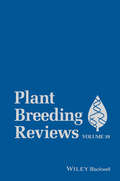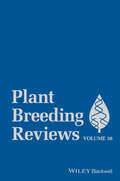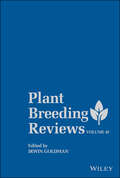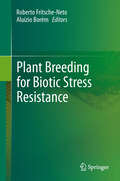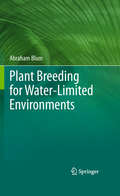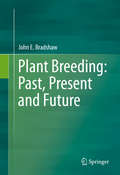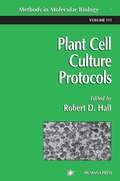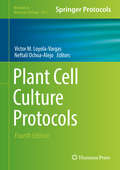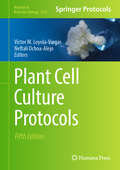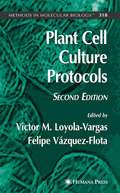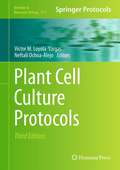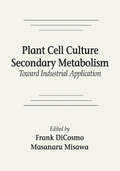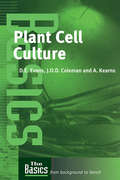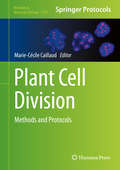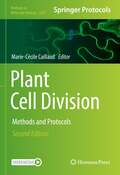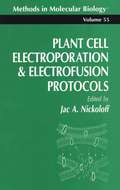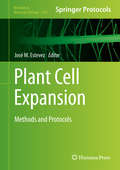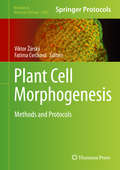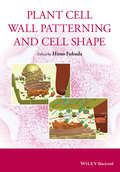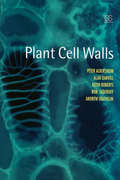- Table View
- List View
Plant Breeding Reviews Volume 39
by Jules JanickCharles W. Stuber: Maize Geneticist and Pioneer of Marker-Assisted SelectionJames B. Holland, Geoffrey I. Graham, J. Paul Murphy, and M. Lynn Senior Plant Mutation Breeding: Current Progress and Future AssessmentSouleymane Bado, Brian P. Forster,Stephan Nielen, Abdelbagi M. Ali, Pierre J. L. Lagoda, Bradley J. Till, and Margit Laimer Recent Advances in Sorghum Biofortification ResearchA. Ashok Kumar, Kotla Anuradha, B. Ramaiah, Stefania Grando, H. Frederick W. Rattunde, Parminder Virk, and Wolfgang H. Pfeiffer Breeding Tropical Vegetable CornsJames L. Brewbaker and Ian Martin Maize Breeding in the United States: Views from Within MonsantoDavid V. Butruille, Fufa H. Birru, Marv L. Boerboom, Edward J. Cargill, Duane A. Davis, Prabhakar Dhungana, Gerald M. Dill, Jr. , Fenggao Dong, Agustin E. Fonseca, Brian W. Gardunia, Gregory J. Holland, Nan Hong, Paul Linnen, Thomas E. Nickson, Nalini Polavarapu, Jerald K. Pataky, Joh Popi, and Steve B. Stark The History, Development and Importance of the New Mexican Pod-Type Chile Pepper to the United States and World Food IndustryPaul W. Bosland Fruit Domestication in the Near EastShahal Abbo, Avi Gopher, and Simcha Lev-Yadun The Geneva Apple Rootstock Breeding ProgramGennaro Fazio, Terence L. Robinson, and Herb S. Aldwinckle
Plant Breeding Reviews, Plant Breeding Reviews
by Jules JanickPlant Breeding Reviews 38 Table of Contents1. Daniel Zohary: Geneticist and Explorer of Plant DomesticationGiora Simchen2. The Use of Association Genetics Approaches in Plant BreedingMaría F. Álvare, Teresa Mosquera, and Matthew W. Blair 3. Epigenetics Connects the Genome to its EnvironmentRay A. Bressan, Jian-Kang Zhu, Michael J. Van Oosten, Hans J. Bohnert, Viswanathan Chinnusamy, and Albino Maggio4. Peanuts Improvement for Human HealthSangam Dwivedi, Naveen Puppala, Soheila Maleki, Peggy Ozias-Akins, and Rodomiro Ortiz5. Rice Breeding in Latin AmericaCésar P. Martínez, Edgar Torres, Marc Châtel, Gloria Mosquera, Jorge Duitama, Manabu Ishitani, Michael Selvaraj, Beata Dedicova, Joe Tohme, Cécile Grenier, Mathias Lorieux. Maribel Cruz, Luis Berrío, Edgar Corredor, Gonzalo Zorrilla de San Martin, Flavio Breseghello, Orlando Peixoto, Jose Manoel Colombari Filho, Adriano Castro, Sergio Iraçu Gindri Lopes, Mara Barbosa, Gustavo Rodrigo Daltrozzo Funck, Pedro Blanco, Fernando Pérez de Vida, Federico Molina, Juan Rosas, Sebastián Martínez, Victoria Bonnecarrere, Silvia Garaycochea, Gonzalo Carracelas, Alfredo Marin, Fernando Correa, and Ismael Camargo
Plant Breeding Reviews, Volume 45 (Plant Breeding Reviews)
by Irwin GoldmanContents Antoine: Slave, Creole Gardener, and Expert Grafter of Pecan Trees 1 Hazelnut Breeding 9 Rewiring Network Plasticity to Improve Crops 143 Accelerating Crop Domestication in the Era of Gene Editing 185 Regional and Global Inter-Connectivity Among Common Bean Breeding Programs 213 The Plant Sciences Symposia Series: A Model for Private Sector Support for Graduate Education 255 Ideas in Genomic Selection with the Potential to Transform Plant Molecular Breeding: A Review 273 Genetic Revelations of a New Paradigm of Plant Domestication as a Landscape Level Process 321 Breeding for Acylsugar-Mediated Control of Insects and Insect-Transmitted Virus in Tomato 345
Plant Breeding Reviews, Volume 46 (Plant Breeding Reviews)
by Irwin GoldmanPlant Breeding Reviews presents state-of-the-art reviews on plant genetics and the breeding of all types of crops by both traditional means and molecular methods. Many of the crops widely grown today stem from a very narrow genetic base; understanding and preserving crop genetic resources is vital to the security of food systems worldwide. The emphasis of the series is on methodology, a fundamental understanding of crop genetics, and applications to major crops.
Plant Breeding for Abiotic Stress Tolerance
by Roberto Fritsche-Neto Aluízio BorémThe rapid population growth and the increase in the per capita income, especially in the group of emerging countries referred to as BRIC countries (Brazil, Russia, India, China and South Africa) has created huge pressure for the expansion of the agricultural growing area and the crop yields to meet the rising demand. As a result, many areas that have been considered marginal for growing crops, due to their low fertility, drought, salinity, and many other abiotic stresses, have now been incorporated in the production system. Additionally, climate change has brought new challenges to agriculture to produce food, feed, fiber and biofuels. To cope with these new challenges, many plant breeding programs have reoriented their breeding scope to stress tolerance in the last years. The authors of this book have collected the most recent advances and discoveries applied to breeding for abiotic stresses in this book, starting with new physiological concepts and breeding methods, and moving on to discuss modern molecular biological approaches geared to the development of improved cultivars tolerant to most sorts of abiotic stress. Written in an easy to understand style, this book is an excellent reference work for students, scientists and farmers interested in learning how to breed for abiotic stresses scenarios, presenting the state-of-the-art in plant stresses and allowing the reader to develop a greater understanding of the basic mechanisms of tolerance to abiotic stresses and how to breed for them.
Plant Breeding for Biotic Stress Resistance
by Roberto Fritsche-Neto Aluízio BorémExperience shows that biotic stresses occur with different levels of intensity in nearly all agricultural areas around the world. The occurrence of insects, weeds and diseases caused by fungi, bacteria or viruses may not be relevant in a specific year but they usually harm yield in most years. Global warming has shifted the paradigm of biotic stresses in most growing areas, especially in the tropical countries, sparking intense discussions in scientific forums. This book was written with the idea of collecting in a single publication the most recent advances and discoveries concerning breeding for biotic stresses, covering all major classes of biotic challenges to agriculture and food production. Accordingly, it presents the state-of-the-art in plant stresses caused by all microorganisms, weeds and insects and how to breed for them. Complementing Plant Breeding for Abiotic Stress Tolerance, this book was written for scientists and students interested in learning how to breed for biotic stress scenarios, allowing them to develop a greater understanding of the basic mechanisms of resistance to biotic stresses and develop resistant cultivars.
Plant Breeding for Water-Limited Environments
by Abraham BlumThis volume will be the only existing single-authored book offering a science-based breeder's manual directed at breeding for water-limited environments. Plant breeding is characterized by the need to integrate information from diverse disciplines towards the development and delivery of a product defines as a new cultivar. Conventional breeding draws information from disciplines such as genetics, plant physiology, plant pathology, entomology, food technology and statistics. Plant breeding for water-limited environments and the development of drought resistant crop cultivars is considered as one of the more difficult areas in plant breeding while at the same time it is becoming a very pressing issue. This volume is unique and timely in that it develops realistic solutions and protocols towards the breeding of drought resistant cultivars by integrating knowledge from environmental science, plant physiology, genetics and molecular biology.
Plant Breeding for the Home Gardener: How to Create Unique Vegetables and Flowers
by Joseph TychonievichBrighter zinnias, fragrant carnations, snappier green beansPlant Breeding for the Home Gardener makes it easier than ever to breed and grow your own varieties of vegetables and flowers. This comprehensive and accessible guide explains how to decide what to breed, provides simple explanations on how to cross plants, and features a basic primer on genetics and advanced techniques. Case studies provide breeding examples for favorite plants like daffodils, hollyhocks, roses, sweet corn, and tomatoes.
Plant Breeding in the Omics Era
by Rodomiro Ortiz RíosThe field of plant breeding has grown rapidly in the last decade with breakthrough research in genetics and genomics, inbred development, population improvement, hybrids, clones, self-pollinated crops, polyploidy, transgenic breeding and more. This book discusses the latest developments in all these areas but explores the next generation of needs and discoveries including omics beyond genomics, cultivar seeds and intellectual and property rights. This book is a leading-edge publication of the latest results and forecasts important areas of future needs and applications.
Plant Breeding: Past, Present and Future
by John E. BradshawThis book aims to help plant breeders by reviewing past achievements, currently successful practices, and emerging methods and techniques. Theoretical considerations are also presented to strike the right balance between being as simple as possible but as complex as necessary. The United Nations predicts that the global human population will continue rising to 9. 0 billion by 2050. World food production will need to increase between 70-100 per cent in just 40 years. First generation bio-fuels are also using crops and cropland to produce energy rather than food. In addition, land area used for agriculture may remain static or even decrease as a result of degradation and climate change, despite more land being theoretically available, unless crops can be bred which tolerate associated abiotic stresses. Lastly, it is unlikely that steps can be taken to mitigate all of the climate change predicted to occur by 2050, and beyond, and hence adaptation of farming systems and crop production will be required to reduce predicted negative effects on yields that will occur without crop adaptation. Substantial progress will therefore be required in bridging the yield gap between what is currently achieved per unit of land and what should be possible in future, with the best farming methods and best storage and transportation of food, given the availability of suitably adapted cultivars, including adaptation to climate change. My book is divided into four parts: Part I is an historical introduction; Part II deals with the origin of genetic variation by mutation and recombination of DNA; Part III explains how the mating system of a crop species determines the genetic structure of its landraces; Part IV considers the three complementary options for future progress: use of sexual reproduction in further conventional breeding, base broadening and introgression; mutation breeding; and genetically modified crops.
Plant Cell Culture Protocols
by Robert D. HallRobert Hall and a panel of expert researchers present a comprehensive collection of the most frequently used and broadly applicable techniques for plant cell and tissue culture. Readily reproducible and extensively annotated, the methods cover culture initiation, maintenance, manipulation, application, and long-term storage, with emphasis on techniques for genetic modification and micropropagation. Many of these protocols are currently used in major projects designed to produce improved varieties of important crop plants. Plant Cell Culture Protocols's state-of-the-art techniques are certain to make the book today's reference of choice, an indispensable tool in the development of new transgenic plants and full-scale commercial applications.
Plant Cell Culture Protocols (Methods in Molecular Biology #1815)
by Víctor M. Loyola-Vargas Neftalí Ochoa-AlejoThis fourth edition provides new and updated protocols on plant cell, tissue, and organ cultures. Chapters are divided into five parts that cover topics from general methodologies, statistical analysis and contamination control, highly specialized techniques, and laborious process of measuring the epigenetics changes in tissue cultures. Written in the highly successful Methods in Molecular Biology series format, chapters include introductions to their respective topics, lists of the necessary materials and reagents, step-by-step, readily reproducible laboratory protocols, and tips on troubleshooting and avoiding known pitfalls. Authoritative and cutting-edge, Plant Cell Culture Protocols, Fourth Edition aims to serve both professionals and novices with its guide to the most common and applicable techniques and methods for plant tissue and cell culture.
Plant Cell Culture Protocols (Methods in Molecular Biology #2827)
by Víctor M. Loyola-Vargas Neftalí Ochoa-AlejoThis fifth edition provides new and updated protocols on plant cell, tissue, and organ cultures. Chapters are divided into five parts that cover topics from general methodologies, statistical analysis and contamination control, highly specialized techniques, and laborious process of measuring the epigenetics changes in tissue cultures. Written in the highly successful Methods in Molecular Biology series format, chapters include introductions to their respective topics, lists of the necessary materials and reagents, step-by-step, readily reproducible laboratory protocols, and key tips on troubleshooting and avoiding known pitfalls. Authoritative and cutting-edge, Plant Cell Culture Protocols, Fifth Edition aims to ensure successful results in the further study of this vital field.
Plant Cell Culture Protocols (Second Edition)
by Víctor M. Loyola-Vargas Felipe Vázquez-FlotaA comprehensive state-of-the-art collection of the most frequently used techniques for plant cell and tissue culture. Readily reproducible and extensively annotated, the methods range from general methodologies, such as culture induction, growth and viability evaluation, and contamination control, to such highly specialized techniques as chloroplast transformation involving the laborious process of protoplast isolation and culture. Most of the protocols are currently used in the research programs of the authors or represent important parts of business projects aimed at the generation of improved plant materials. Two new appendices explain the principles for formulating culture media and the composition of the eight most commonly used media formulations, and list more than 100 very useful internet sites.
Plant Cell Culture Protocols (Third Edition)
by Víctor M. Loyola-Vargas Neftalí Ochoa-AlejoCell culture methodologies have become standard procedures in most plant laboratories. Currently, facilities for in vitro cell cultures are found in practically every plant biology laboratory, serving different purposes since tissue culture has turned into a basic asset for modern biotechnology, from the fundamental biochemical aspects to the massive propagation of selected individuals. "Plant Cell Culture Protocols, Third Edition is divided into five convenient sections that cover topics from general methodologies, such as culture induction, growth and viability evaluation, statistical analysis and contamination control, to highly specialized techniques, such as clonal propagation, haploid production, somatic embryogenesis, organelle transformation. The volume concludes with a section on the laborious process of measuring the epigenetics changes in tissue cultures."Written in the successful Methods in Molecular BiologyTM series format, chapters include introductions to their respective topics, lists of the necessary materials and reagents, step-by-step, readily reproducible protocols, and notes on troubleshooting and avoiding known pitfalls. Authoritative and easily accessible, Plant Cell Culture Protocols, Third Edition seeks to serve both professionals and novices with its guide to the most common and applicable techniques and methods for plant tissue and cell culture.
Plant Cell Culture Secondary MetabolismToward Industrial Application
by Frank DiCosmoPlant cell cultures are used extensively in studies of secondary metabolism, for the biosynthesis of pharmaceuticals, flavors, essences, and pigments. This book highlights recent developments in the in vitro growth of cultured plant cells and in the production of valuable secondary metabolites.Plant Cell Culture Secondary Metabolism details research on many exciting areas including:
Plant Cell Culture: Crop Species (The\basics (garland Science) Ser.)
by David Evans Anne Kearns Julian ColemanPlant cell culture is an essential methodology in plant sciences, with numerous variant techniques depending on the cell type and organism. Plant Cell Culture provides the reader with a concise overview of these techniques, including basic plant biology for cell culture, basic sterile technique and media preparation, specific techniques for various plant cell and tissue types including applications, tissue culture in agriculture, horticulture and forestry and culture for genetic engineering and biotechnology. This book will be an essential addition to any plant science laboratory's bookshelf.
Plant Cell Division: Methods and Protocols (Methods in Molecular Biology #1370)
by Marie-Cécile CaillaudThis volume aims to present a large panel of techniques for the study of Plant Cell Division. Plant Cell Division: Methods and Protocols captures basic experimental protocols that are commonly used to study plant cell division processes, as well as more innovative procedures. Chapters are split into five parts covering several different aspect of plant cell division such as, cell cultures for cell division studies, cell cycle progression and mitosis, imaging plant cell division, cell division and morphogenesis, and cytokinesis. Written for the Methods in Molecular Biology series, chapters include introductions to their respective topics, lists of the necessary materials and reagents, step-by-step, readily reproducible laboratory protocols, and tips on troubleshooting and avoiding known pitfalls.Authoritative and practical, Plant Cell Division: Methods and Protocols is a valuable tool for the study of plant cell division at both the cellular and molecular levels, and in the context of plant development.
Plant Cell Division: Methods and Protocols (Methods in Molecular Biology #2382)
by Marie-Cécile CaillaudThis new edition explores innovative approaches and keystone methodologies reflecting the recent advances in the field of plant cell division that have enabled us to study this fascinating process in a quantitative manner, at high resolution both in space and time using cell biology, biochemistry, and molecular biology. After a review of the methods used to visualize the actin cytoskeleton during plant cell division, the book focuses first on methodology to address mitosis progression as a part of the cell cycle. It continues with sections on manipulation of cell division, quantification of cell division patterning, as well as imaging and quantifying plant cytokinesis. Written for the highly successful Methods in Molecular Biology series, chapters include introductions to their respective topics, lists of the necessary materials and reagents, step-by-step, readily reproducible laboratory protocols, and tips on troubleshooting and avoiding known pitfalls. Authoritative and up-to-date, Plant Cell Division: Methods and Protocols, Second Edition serves as an ideal guide for researchers attempting to visualize, quantify, and modify cell division during cell cycle progression.
Plant Cell Electroporation And Electrofusion Protocols
by Jac A. NickoloffLeading experts and innovators describe in detail plant cell electroporation and electrofusion techniques for many types of plants. Their protocols cover a diverse set of plant cell types, including different cell types from a single organism (i.e., leaf cells and pollen) and the most important model plants, including maize and tobacco. Each protocol also contains detailed instructions for growth and growth optimization, protoplast generation, and protoplast regeneration for specific plant cell types, along with extensive troubleshooting advice and descriptions of expected results to simplify study design.
Plant Cell Expansion: Methods and Protocols (Methods in Molecular Biology #1242)
by José M. EstevezThis volume covers broad aspects of cell expansion in three different cell types: root hairs, pollen tubes, and hypocothyl cells. Chapters focus on the cutting-edge methods to study in detail several complex aspects of cell expansion such as secretion, endocytosis and recycling, cellular signaling and trafficking, and protein and polysaccharides cell wall biosynthesis in real time during cell expansion. Written in the highly successful Methods in Molecular Biology series format, chapters include introductions to their respective topics, lists of the necessary materials and reagents, step-by-step, readily reproducible laboratory protocols, and tips on troubleshooting and avoiding known pitfalls.Authoritative and practical, Plant Cell Expansion: Methods and Protocols is an essential reference book for plant scientist, molecular, and cell biologist as well as plant biochemists.
Plant Cell Morphogenesis: Methods and Protocols (Methods in Molecular Biology #1080)
by Viktor Žárský Fatima CvrčkováPlant Cell Morphogenesis: Methods and Protocols provides a collection of experimental techniques used in current research on the cellular aspects of plant morphogenesis. Methods and techniques include contemporary takes on classical light microscopy and histochemistry through automated microscopy applications, use of advanced optical tools, quantitative image analysis, study of cellular dynamics of apical meristems, specialized electron microscopy techniques, and methods used to study specific model plant cell types and protocols for using heterologous expression in yeast to study cell morphogenesis genes. Individual chapters in the highly successful Methods in Molecular Biology series format are written by expert researchers in the field and include introductions to their respective topics, lists of the necessary materials and reagents, step-by-step laboratory protocols, and key tips on troubleshooting and avoiding known pitfalls.
Plant Cell Morphogenesis: Methods and Protocols (Methods in Molecular Biology #1992)
by Viktor Žárský Fatima CvrčkováThis book collects techniques to continue exploring post-genomic land plant biology though the wisdom and skills accumulated from work on the founding molecular biology models that can now guide research into other species, including crop plants. Beginning with the visualization of plant cell structures, the volume moves on to cover digital image analysis protocols, qualitative and quantitative detection of the organization and dynamics of individual intracellular structures, the manipulation of intracellular structures, as well as techniques for studying model cell types. Written for the highly successful Methods in Molecular Biology series, chapters include introductions to their respective topics, lists of the necessary materials and reagents, step-by-step, readily reproducible laboratory protocols, and tips on troubleshooting and avoiding known pitfalls. Authoritative and fully updated, Plant Cell Morphogenesis: Methods and Protocols, Second Edition serves as an ideal source of inspiration for further research into the morphogenesis of plant cells, tissues, and organs.
Plant Cell Wall Patterning and Cell Shape
by Hiroo FukudaCell walls are defining feature of plant life. The unique and multi-faceted role they play in plant growth and development has long been of interest to students and researchers. Plant Cell Wall Patterning and Cell Shape looks at the diverse function of cell walls in plant development, intercellular communication, and defining cell shape.Plant Cell Wall Patterning and Cell Shape is divided into three sections. The first section looks at role cell walls play in defining cell shape. The second section looks more broadly at plant development. While the third and final section looks at new insights into cell wall patterning.
Plant Cell Walls
by Keith Roberts Peter Albersheim Alan Darvill Ron Sederoff Andrew StaehelinPlant cell walls are complex, dynamic cellular structures essential for plant growth, development, physiology and adaptation. Plant Cell Walls provides an in depth and diverse view of the microanatomy, biosynthesis and molecular physiology of these cellular structures, both in the life of the plant and in their use for bioproducts and biofuels. Plant Cell Walls is a textbook for upper-level undergraduates and graduate students, as well as a professional-level reference book. Over 400 drawings, micrographs, and photographs provide visual insight into the latest research, as well as the uses of plant cell walls in everyday life, and their applications in biotechnology. Illustrated panels concisely review research methods and tools; a list of key terms is given at the end of each chapter; and extensive references organized by concept headings provide readers with guidance for entry into plant cell wall literature.Cell wall material is of considerable importance to the biofuel, food, timber, and pulp and paper industries as well as being a major focus of research in plant growth and sustainability that are of central interest in present day agriculture and biotechnology. The production and use of plants for biofuel and bioproducts in a time of need for responsible global carbon use requires a deep understanding of the fundamental biology of plants and their cell walls. Such an understanding will lead to improved plant processes and materials, and help provide a sustainable resource for meeting the future bioenergy and bioproduct needs of humankind.
